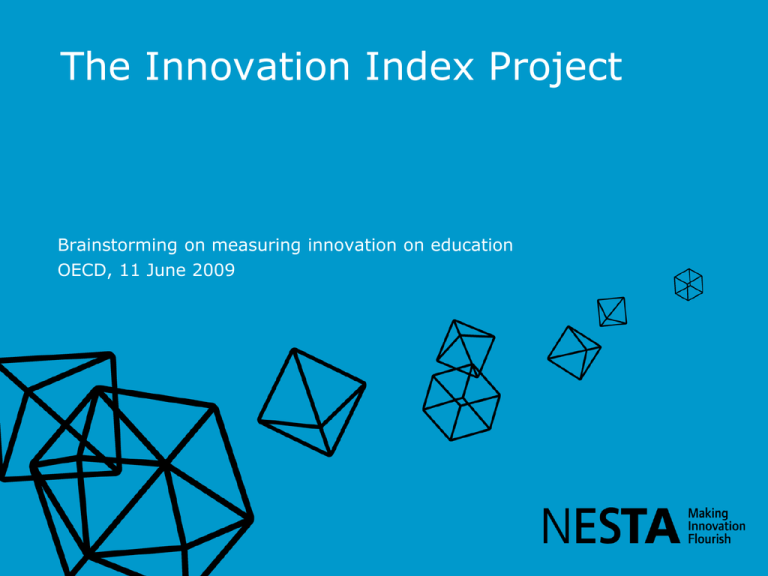Innovation growth accounting
advertisement

The Innovation Index Project Brainstorming on measuring innovation on education OECD, 11 June 2009 Why a new Innovation Index for the UK? Most traditional innovation indicators (e.g., R&D, patents): • Biased towards manufacturing innovations based on basic scientific breakthroughs (the “linear” model of innovation) • Fail to capture innovation in the UK’s increasingly important services sectors, creative industries and in the delivery of public services. • And focus innovation policy on improving “incomplete” metrics DIUS White Paper: A new innovation index is needed Aims & Timetable Policy makers are the main audience, but output must be credible with the private sector and the academic community Provide a better account of innovation in the UK, which includes `hidden innovation’, user-led innovation and innovation in public services As far as practicable, be comparable across similar sectors across different countries September 2008: Scoping “MiniProjects” January 2009: Commission Main Components Autumn 2009: Publication Pilot “Index” Autumn 2010: Publication Full “Index” Private Sector Index Update 1. Innovation growth accounting (18 months) • Imperial College and ONS (Jonathan Haskel and Tony Clayton) 2. Firm-level innovation performance (7 months) • University of Warwick (Stephen Roper, Jim Love and John Bryson) 3. Wider/Framework Conditions (7 months) • GHK, Technopolis and Manchester University (Manchester Institute of Innovation Research) 4. Measuring user-led innovation (7 months) • CENTRIM, MIT and EIM (Steve Flowers, Eric von Hippel and Jeroen de Jong) 1. Innovation growth accounting • • Main indicators: • Investment in innovation, going beyond R&D • Contribution of investment in innovation to labour productivity growth, distinguishing between different types of investment • Total Factor Productivity (TFP) growth, accounting for the role of intangibles. Process: • Focus on software, R&D, design spending, financial services, marketing, human capital and organisational capital • Exploit labour force survey data to build measures of investment • Run extended R&D survey and conduct industry fora • Test assumptions underlying metrics and growth accounting 2. Firm-level innovation performance • Main indicators: • Sector-specific indicators of innovation activity • Innovation capabilities map (per sector and innovation process stage) • 6 areas of the UK economy in 2009 (10 sectors): legal services, consultancy services, accountancy services (as part of knowledge intensive business services); software and IT services; architecture and design (as part of creative services); aerospace, automotive (as part of high-value manufacturing); construction; and energy production. • Process: • Implement a peer review process with industry practitioners to validate indicator choice (sector-specific) • Run firm survey to collect data on the selected indicators 3.Wider/Framework Conditions • • Main indicators: • Indicators for the most important drivers of innovation activity outside the firm/organization • It may include, among others, skills, entrepreneurship and growth, finance, “demand”, intellectual property rights, collaboration and competition Process: • Develop selection criteria to choose among potential frameworks and different indicators • Compile data based on existing sources on the selected indicators at a national and regional level • Consider the distinctive role that specific conditions have for some industries 4. Measuring user-led innovation • Main indicators • Indicators for user innovation by firms and individual end consumers • Process: • Undertake a firm level survey to measure user innovation in UK firms • Undertake two surveys on end consumers to measure the involvement of UK end-consumers in the innovation process 5. The Public Sector/Services: Work so far • Commissioning two scoping projects on public sector innovation – LSE, Technopolis • Engaging with and advising on other initiatives in the UK and internationally including: o National Audit Office study o NHS Innovation metrics project o OECD revision of ‘Oslo Manual’ o UKIPO measurement of intangible assets o Nordic Initiative • Organising OECD-DIUS-Nordic-NESTA conference to share thinking and developing international co-operation Determining parameters: some choices Public sector Public services Performance tool Sector statistics Balanced score card ‘Return on investment’ data Health innovation metrics: DH/NHS approach Innovation metric Support for collection No. of ideas identified SHA National Grid for Innovation No. of ideas grown, piloted and adopted (financial/human resources invested) SHA National Grid for Innovation No. of ideas diffused SHA National Grid for Innovation Economic value of innovations (£s) Valuation models Patient value of innovations (QALYs and others) Valuation models Staff perception of innovation environment NHS staff survey What’s relevant to measure? Characteristics of an innovative public sector • Culture of continuous improvement that incentivises public bodies, their staff and stakeholders to innovate • Openness to innovative ideas and able to source innovations from outside and within • Making decisions and allocating funding quickly to develop, trial and test innovations • Identifying what works and comparing with existing delivery methods • Allocating funding to scale and rolling out successful innovations with support for adopters • Closing down unsuccessful innovation projects Within the Index conceptual framework: generic indicators for the public sector Inputs Outputs of innovation activity Adoption of innovation Wider Conditions Outcomes Aspect of innovation Some potential indicators Inputs Investment in innovation or capability to innovate: spending; procurement & commissioning strategies; sourcing; support for innovators Outputs New products, services, processes, delivery models; patents; copyrights Adoption Adoption of new to organisation products, services processes, procedures , delivery models; mechanisms for sharing learning and encouraging adoptions across and between organisations Outcomes Cost-benefit analysis and other assessments of ‘value added’ of innovation; customer and staff satisfaction measures; productivity and quality measures; performance measures Proposed public sector outputs 1. A set of input, output, adoption and outcome indicators that measure some or all dimensions of public sector innovation processes 2. A methodology piloted by NESTA for capturing public sector innovation data that can be later adopted by others 3. Depending on progress on the private sector components of the Index, additional outputs such as work on framework conditions and public sector productivity Next steps – Phase 1 2009-10 May-Aug 09 Stakeholder consultation on data collection and willingness to participate in trial; survey design Sept 09 Trial surveying and data collection (c.10 orgs.) Oct-Nov 09 Interim report: present findings in UK and at international workshop Nov-Jan 10 Main pilot surveying and data gathering March 10 Pilot study report published, including indicators and some ’worked examples’ of interpretation Next steps – Phase 2 2010 -11 April-June 2010 Stakeholder consultation and development of indicators with additional public service delivery areas – for example Education, Policing, Social Care; refinement of Phase 1 indicators April 2010-Jan 2011 Further work on outcome indicators and Phase 2 surveying March 2011 Final report/outputs: indicators, methodological ’toolkit’ and outcome measures www.innovationindex.org.uk innovationindex@nesta.org.uk








